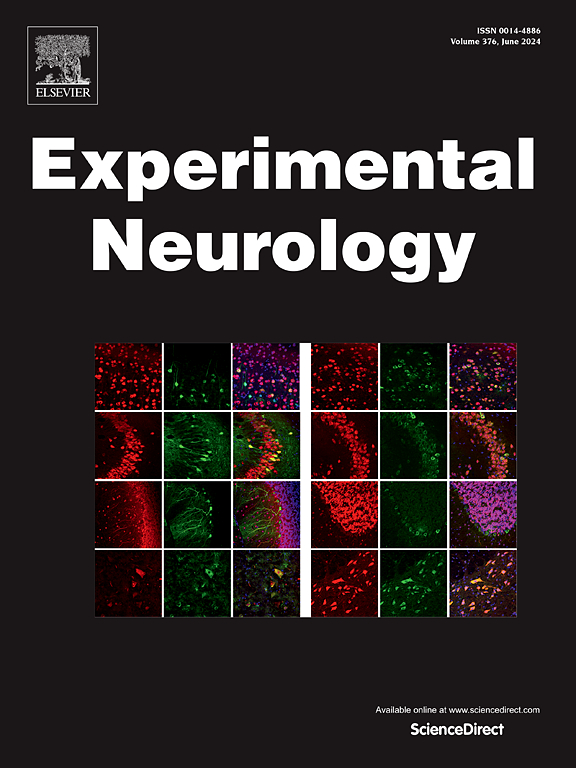Wolfram综合征准确模型的早期三叉神经和感觉障碍及溶酶体功能障碍。
IF 4.6
2区 医学
Q1 NEUROSCIENCES
引用次数: 0
摘要
Wolfram综合征(WS)是一种罕见的疾病,主要由WFS1基因纯合或复合杂合突变引起。诊断依据为早发性糖尿病及视神经萎缩。患者主诉为三叉神经样偏头痛,并表现出振动感觉的缺陷,但根本原因尚不清楚。利用准确的细胞模型和两个独立的、准确的WS啮齿动物模型,我们研究了WS中三叉神经、感觉和感觉神经元的功能。体外和体内MRI序列分析显示,每个啮齿动物模型的三叉神经严重萎缩,这是WS的新发现。视神经萎缩是WS的一个诊断征象,三叉神经萎缩发生在视神经体积损失最早的时候。我们还在小鼠WS模型中观察到机械感觉缺陷,病理分析显示三叉神经感觉核广泛炎症,这两者都是WS的新发现。感觉神经元(背根神经节)在去极化时钙处理受损,线粒体膜电位降低。最后,溶酶体变小,胞体溶酶体含量减少,重要的是,感觉神经元溶酶体酸度受损,这些都是WS的新发现。我们使用两个独立的公开数据集验证了这些发现,这两个数据集都来自WS患者成纤维细胞来源的神经干细胞。我们观察到,在差异表达的蛋白质和基因中,氧化石墨烯细胞组分溶酶体相关术语的功能显著富集,大部分溶酶体相关蛋白被下调。这些数据揭示了WS中三叉神经通路和伤害性神经元的广泛损伤,这可能导致患者观察到的三叉神经和感觉症状。此外,我们注意到WFS1的突变是相对常见的,并且考虑到WFS1对感觉功能的重要性,我们的数据也可能揭示一般的感觉障碍。本文章由计算机程序翻译,如有差异,请以英文原文为准。

Early trigeminal and sensory impairment and lysosomal dysfunction in accurate models of Wolfram syndrome
Wolfram syndrome (WS) is a rare condition caused by homozygous or compound heterozygous mutations in the WFS1 gene primarily. It is diagnosed on the basis of early-onset diabetes mellitus and optic nerve atrophy. Patients complain of trigeminal-like migraines and show deficits in vibration sensation, but the underlying cause is unknown. Using accurate cell models and two separate, accurate rodent models of WS that show excellent face and construct validity, here we have examined trigeminus, sensation and sensory neuronal function in WS. Analysis of ex vivo and in vivo MRI sequences revealed profound trigeminal atrophy in each rodent model, a novel finding in WS. Optic nerve atrophy is a diagnostic sign in WS, and trigeminal atrophy occurred at the time of earliest loss of optic nerve volume. We also observed deficits in mechanical sensation in our mouse WS model, and pathological analysis revealed extensive inflammation in trigeminal sensory nucleus, both of which are novel findings in WS. Sensory neurons (dorsal root ganglia) showed impaired calcium handling upon depolarisation and reduced mitochondrial membrane potential. Finally, lysosomes were smaller, soma lysosome content was decreased and importantly, lysosome acidity was impaired in sensory neurons, all of which are novel findings in WS. We validated these findings using two separate publicly available datasets, both from WS patient fibroblast-derived neural stem cells. We observed a highly significant functional enrichment of GO cellular component lysosome-related terms among the differentially expressed proteins and genes, with the majority of lysosome-related proteins being downregulated. These data reveal extensive impairments in the trigeminal pathway and nociceptive neurons in WS that may contribute to trigeminal and sensory symptoms observed in patients. Moreover, we note that mutations in WFS1 are relatively common and, given the importance of WFS1 for sensory function, our data may also shed light on sensory impairments in general.
求助全文
通过发布文献求助,成功后即可免费获取论文全文。
去求助
来源期刊

Experimental Neurology
医学-神经科学
CiteScore
10.10
自引率
3.80%
发文量
258
审稿时长
42 days
期刊介绍:
Experimental Neurology, a Journal of Neuroscience Research, publishes original research in neuroscience with a particular emphasis on novel findings in neural development, regeneration, plasticity and transplantation. The journal has focused on research concerning basic mechanisms underlying neurological disorders.
 求助内容:
求助内容: 应助结果提醒方式:
应助结果提醒方式:


